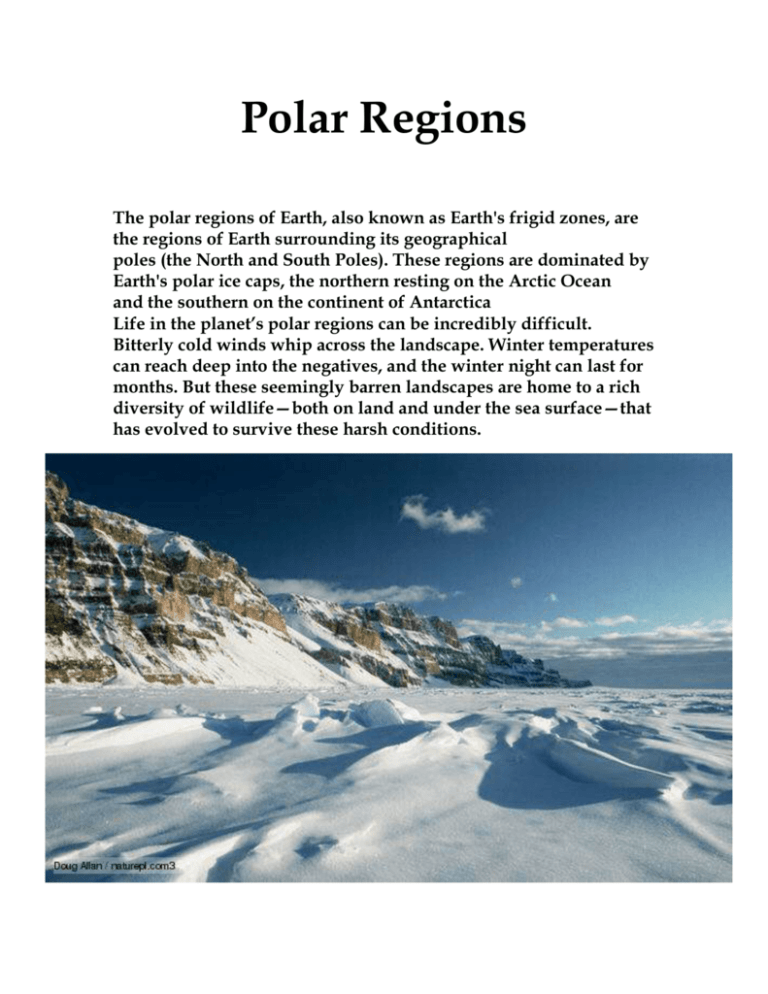Polar Regions - Miss. Mackenzie Raatz
advertisement

Polar Regions The polar regions of Earth, also known as Earth's frigid zones, are the regions of Earth surrounding its geographical poles (the North and South Poles). These regions are dominated by Earth's polar ice caps, the northern resting on the Arctic Ocean and the southern on the continent of Antarctica Life in the planet’s polar regions can be incredibly difficult. Bitterly cold winds whip across the landscape. Winter temperatures can reach deep into the negatives, and the winter night can last for months. But these seemingly barren landscapes are home to a rich diversity of wildlife—both on land and under the sea surface—that has evolved to survive these harsh conditions. Polar Bear Polar bears live in the Arctic. They do not stay in one place. They travel across the snow and pack ice looking for food. Sometimes they swim far out to sea. Polar bears are the largest bears in the world. Adults weigh 295 kg to 600 kg (650 to 1300 pounds). Males are larger than females. A polar bear's coat can be from white to yellowish in color. Seals are their favorite food, especially the ringed seal. Polar bears spend most of their time on the pack ice or in the water, where they can hunt for the seal. The white fur helps the bear sneak up on seals that are laying on the ice. The polar bear waits by the seal's breathing holes in the ice and quickly snatches the seal when it pokes its head out of the hole. Polar bears are able to swim in the icy Arctic Ocean without freezing. They have thick oily fur coats and a layer of fat (blubber) under their skin. When bears comes out of the water they shake the water off their coats. The bear's large feet are like snowshoes. The hair on the soles of its feet help the bear walk on the slippery ice and snow. The bear walks with toes pointing inward to avoid slipping. Polar bears are good swimmers. They have large front paws with partially webbed toes. They paddle with their front legs and use their hind legs as rudders. The polar bear has a very good sense of smell and can sniff dead animals from far away and can find seals in dens beneath the snow. Arctic Fox This fox is found in the far north, mainly in the Arctic Circle. (northern parts of Alaska and the Northwest Territories, Nunavut, on Iceland , northern Russia and on the coast of Greenland). The Arctic fox lives in a den or burrow dug into the side of a hill, cliff or riverbank. The den has more than one entrance. In winter it may tunnel into a snow bank. The Arctic fox is well adapted to live in the cold Arctic. In winter its thick, bushy coat turns white. This makes it very hard to see the fox. The prey is not able to spot the Arctic fox until it is too late. Because of its thick coat, it is able to survive in freezing cold temperatures. Thick hair on the pads of their feet protects their feet from freezing and helps them to walk on the ice. The Arctic fox can walk on ice without slipping. It uses ice floes to travel in search of food in the winter. It can curl up in the snow and cover its nose and face with its bushy tail to keep warm. In the summer the fox will hide food in its den or under rocks. This is how it stores food for later use. The Arctic fox is small (about the same size as a large cat) with short legs and short rounded furry ears. The bushy tail is about 30 cm. long. Its thick fur coat makes it look much larger than it really is. When the snow starts to melt, the fox sheds its winter coat for a thinner greyish-brown coat. Near the end of summer the Arctic fox begins to grow a thicker coat again. The color of the fur turns grey and then white. The oily fur sheds water and helps to keep the fox dry. Arctic Wolf The Arctic Wolf is also called the Polar Wolf or White Wolf. It is a subspecies of the Grey Wolf. Arctic wolves live on islands in the Canadian High Arctic. They are also found on the northern and eastern shores of Greenland. They are usually white in color and smaller than Grey Wolves (which live farther south). The white fur makes them harder to see in the snow. The muzzle and legs are shorter and the ears are smaller than the Grey Wolf. Smaller ears and a shorter muzzle help to trap body heat. The Arctic Wolf has a thick undercoat of soft fur and an overcoat of long thick hairs. There are thick pads on the bottoms of the feet. Wolves hunt in small packs. Each pack hunts and lives in its own territory. They are able to live in darkness for months. They hunt musk oxen, caribou, lemmings and arctic hare. Wolves will also eat birds, seals, arctic foxes and ground squirrels. When following herds of musk oxen or caribou, they usually pick on the young or the weak. They travel great distances to find food and can go for days without eating. Penguins Some Penguins live in the Antarctic, where it is extremely cold, and the water temperatures never rise above freezing. Others live further North, but all penguins live in the Southern Hemisphere. Penguins are flightless birds, but are excellent swimmers. They live on pack ice and in the oceans around Antarctica. They breed on the land or ice surfaces along the coast and on islands. Penguins have webbed feet for powerful swimming. Their bodies are streamlined to reduce drag in water. Their wings, shaped like flippers, also help them "fly" underwater at speeds up to 15 mph. Penguins have to keep high body temperatures to remain active. They have thick skin and lots of fat (blubber) under their skin to keep warm in cold weather. They also huddle together with their friends to keep warm. Emperor penguins have developed a social behaviour that when it gets cold, they huddle together in groups that may comprise several thousand penguins. The dark coloured feathers of a penguin's back surface absorb heat from the sun, so helping them to warm up too. Penguins also have special adaptations to allow them to drink sea water and excrete the salt from a special gland near their eyes. They also have adaptations that allow them to dive to great depths and stay submerged for long periods without the need to breathe.






